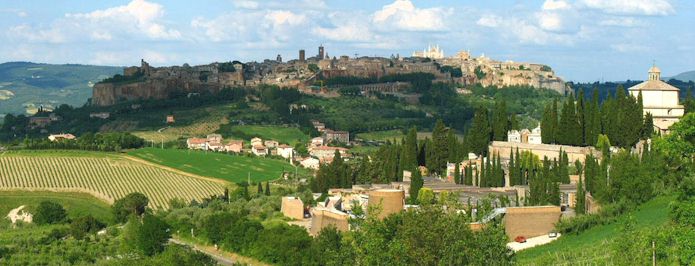Umbria
is comparatively neglected by tourists and other visitors
who head for Florence but much less often for southern
Tuscany and its southerly neighbour, Umbria. Here we provide
some information that should help guide visitors on what to
see in Umbria. Our video gives a hint at the many
things to see in Umbria. The information and links below give more
detailed information on the main sights of interest to
visitors to Umbria. We look forward to seeing you here!
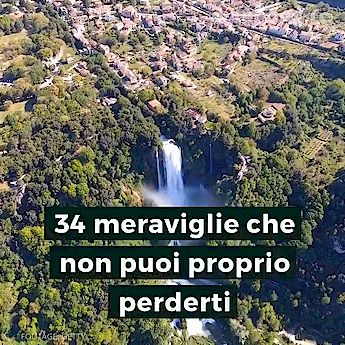
Click the image
above for our 3 minute video introducing
34 marvels of Umbria that you should not miss seeing.
In Italy, Umbria
is second only to Tuscany
in terms of historical hills towns and beautiful countryside.
Along with Tuscany and Sicily, Umbria has sizeable cypress
forests in addition to pine and chestnut. In addition, Umbria is easy to reach
from the big tourism hubs of central Italy and yet relatively uncrowded even at
the height of the tourism season. It has good train and bus connections. All of
the towns of Umbria are relatively small and yet they are
the home of world-class museums and the
remains
of Roman Umbria the equivalent of which are essentially absent in
Tuscany.
Etruscan remains in Umbria
are on a par with those of Tuscany. The Renaissance was undoubtedly born in Tuscany
but it flowered equally in Umbria where every town, even when its character is
essentially mediaeval, is the home of wonderful Renaissance architecture. And,
like every region of Italy, Umbria has its own cuisine and not a few towns known for their
specialities, Norcia being the most famous. Umbria offers a range of enjoyable
annual fairs, events, sagre and feste.
The principal places to visit and things to do in Umbria, Italy:
Assisi,
Umbria
Assisi
is
very popular and therefore sometimes crowded, but rightly so. The popularity of Saint Francis has meant that over several hundred years splendid churches and related structures have been created in Assisi and filled with wonderful frescoes and paintings. Assisi also offers a first rate mediaeval festival, the
Calendimaggio Festival, taking place shortly after 1 May. There are also a number of Roman structures in Assisi that, in any other town, would be major attractions in themselves.
More about Assisi.
Cittą della Pieve, Umbria
Cittą della Pieve is located close to the Tuscan
boundary and can easily be visited from Chiusi in Tuscany as
well as from your base in Umbria. Cittą della Pieve was a
major producer of bricks and therefore, unusually for
central Italy, almost all of its buildings are of brick. It
is most famous as the birthplace of Perugino and some of his
most famous works may be seen here. The
Palio dei Terzieri,
one of the best of the annual folkloric events in Umbria and
Tuscany, takes place during several days of August and is
well worth seeing.
More about
Cittą
della Pieve.
Deruta,
Umbria
Deruta
is justly famous for its hand-painted ceramics. The local clay is good for ceramics, and pottery production is documented from the Early Middle Ages. Artistically, Deruta majolica attained its artistic peak in the 15 C and the early 16 C, with highly characteristic local styles, such as the "Bella Donna" plates. The lack of anything other than wood fuel enforced low firing temperatures, but from the beginning of the 16 C, Deruta compensated with its metallic lustre glazes in golds and ruby red. In the 16 C, Deruta produced the so-called "Rafaellesque-ware", decorated with fine arabesques and
grotesques on a white ground and named after Raphael who originated these designs. They were probably copied by Deruta potters from popular engravings of Raphael's work.
More
about
Deruta.
Gubbio, Umbria
Gubbio
is a decidedly mediaeval town built up the slopes of Mount Ingino with several large Roman ruins nearby. Gubbio is famous for
the crossbow tournament known as the Palio
della Ballestra
and for the
Corsa dei Ceri, which takes
place on 15 May.
For the Corsa, three brightly-costumed teams run from the main square in front of the Palazzo dei Consoli up the steep hillside to the Basilica of S. Ubaldo, each team carrying a statue of
its saint, weighing around 280 kg.
More
about
Gubbio.
Narni, Umbria
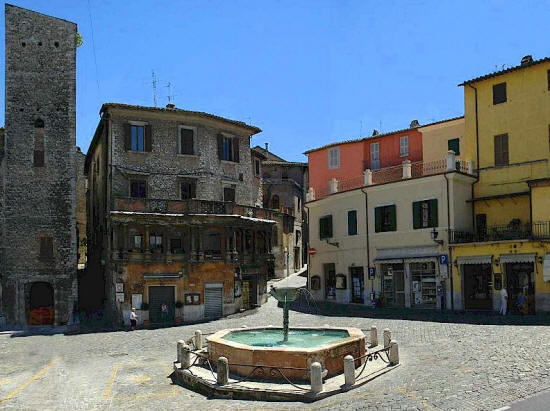
Narni
has been an occupied site for at least three thousand years.
From Roman times, the most spectacular remnant are the
Ponte di Augusto, and the Ponte Cardona bridges,
and the Formina aqueduct. Narni also offers many
mediaeval structures including the Cathedral of San
Giovenale, the Church of San Domenico, currently
the library and the Historical Archives, and the Church
of Santa Maria Imprensole (1175), jewel of Narni's
Romanesque architecture. Other churches of interest are
Sant'Agostino (15 C), and San Francesco (14 C).
The Piazza dei Priori is the locattion of the austere
Palazzo del Podestą, now the Town Hall, decorated
with Roman and mediaeval marble work, a painting by
Ghirlandaio, and a fresco by Lo Spagna, plus the Loggia
dei Priori. The Rocca Albornoziana is a huge
castle, dating from the 14 C and overlooking the town.
More
about
Narni.
Norcia, Umbria
Norcia
is unusual among the towns of Umbria in being located in a
flat basin surrounded by the domed Sybilline mountains which
rise to 2,476 m. at Monte Vettore. Norcia is also
comparatively spacious for a small town which makes it
especially pleasurable to explore. It is the birthplace of
Saint Benedict and is suitably provided with interesting and
beautiful architecture. Norcia is also especially famous for
its pork products. At the very least, try a plate of pork
sausages and lentils during your visit.
More
about Norcia.
Orvieto, Umbria
Orvieto
is famous for its location on an elevated tufa plateau and for its spectacular Gothic cathedral, visible from miles around. The exceptional views commanded by Orvieto, as well as the beautiful skyline of the town itself, can be best enjoyed from the top of the 13 C Torre del Moro. Orvieto is now car-free, with access either via the funicular that runs from the railway station below up to the old town centre or by using the system of escalators dug into the
side of cliff, starting from the large parking lot at Campo della Fiera. There is also a regular minibus service that covers the entire city.
More
about
Orvieto.
Panicale, Umbria
Panicale is a charming, mostly
mediaeval, walled town about 6 km from Lake
Trasimeno over which it offers a splendid view. The
islands of the lake are sharply visible on a clear day. The
few streets form concentric ovals that lead to the main
piazza, Piazza Grande, which is the location of a fine 15 C
fountain. For such a small town, Panicale has some
remarkable art including two works of
Perugino, one a
magnificent fresco, in the Church of San Sebastiano. Panicale
also has some interesting architecture in the form of the Lombard-Gothic
Palazzo del Podestą and its churches. The 18
C Cesare Caporali Theatre is one of the smallest in
Umbria, with 154 seats, only 20 of which are in the pit. Panicale is well-provided with accommodation and
good restaurants.
More about
Panicale.
Perugia, Umbria
Perugia,
the capital of the region of Umbria, is arguably the foremost town in Umbria
for art and architecture. It is a town of considerable charm
in its own right that should not be missed by anyone
interested in Etruscan history and architecture, and in High
Renaissance art. Perugia is home to two universities with
the result that there is a large element of "youth
culture" evident, notably at night. This will be
positive or negative, depending in large part on your age. The Umbria Jazz Festival is one of the most important venues for Jazz in Europe and is held usually in July.
More about Perugia.
Spello, Umbria
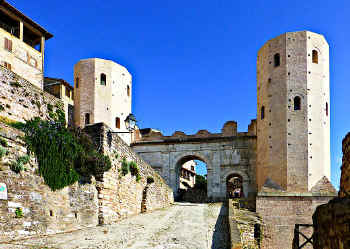
Even by Umbrian standards,
Spello
is characterised by an unusually large number of
well-preserved Roman remains including the foundations of the circuit of mediaeval walls, three Late Antique Roman gates (Porta Consolare, Porta di Venere and the "Arch of Augustus") and traces of three more, plus remains of an
amphitheatre.
The architecture of the town is largely mediaeval, with several mediaeval gates, about
two dozen small mediaeval
churches,
among them Santa Maria Maggiore, first documented in 1159
and probably constructed on top of an ancient temple dedicated to Juno and
Vesta, and three fine palazzi.
More
about Spello.
Spoleto, Umbria
The earliest records of
Spoleto refers to the establishment of a Roman colony in the area in 241 BC. Under the Roman empire, Spoleto seems to have flourished, but it is not often mentioned in ancient history. Under the Lombards, Spoleto became the capital of the independent
Duchy of Spoleto (from 570), and its dukes ruled a considerable part of central Italy. In 774 it became part of Holy Roman Empire, but by 1213 it was definitively incorporated into the Papal States by Pope Gregory IX. During the absence of the papal court in Avignon,
Spoleto was prey to the struggles between
Guelphs and
Ghibellines, until in 1354
it was brought once more under the authority of the Papal States. In 1860 Spoleto was taken by the troops fighting for the unification of Italy.
Spoleto is located among the foothills of the Apennines and is a perfect stop for visitors to nearby
Trevi, Terni and Perugia. One of the most
interesting sights to visit in Spoleto is the 14 C Rocca
Albornoziana, with its six large towers and beautiful interior courtyard surrounded by a loggia spread over two floors. Some of the rooms are decorated with several beautiful frescoes dating back to the 15 C.
The Festival dei Due Mondi (Festival of the Two
Worlds), which was initiated in 1958 and is held annually in late
June / early July, has developed into one of the most important cultural events in Italy, with a three-week schedule of music, theatre and dance performances.
More about
Spoleto.
Todi, Umbria
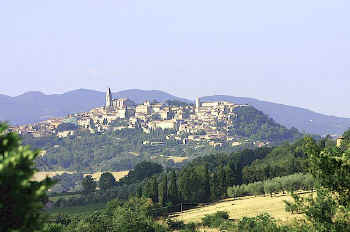
Todi is located near the River Tiber and overlooks the Tiber
Valley (Valtiberina). It is a picturesque mediaeval hill town, surrounded by mediaeval, Roman and Etruscan walls. Although Todi is a hill town, its centre at the top of the hill is flat. The central piazza, originally the Roman forum, has several beautiful
mediaeval
buildings, including the Palazzo del Popolo, one of Italy's oldest public buildings, and
the Palazzo dei Prioi has an unusual trapezoid shaped bell tower.
There are Roman cisterns beneath the piazza that may be visited.
The sights are close together and there are good places to linger, enjoying the views or the ambiance.
The Todi Art Festival takes place in July with art exhibits, drama, opera, classical music and ethnic music performances. The
Gran Premio Internazionale Mongolfieristico, an international
ballooning competition, also takes place in July, with as many as fifty hot air balloons from Europe and the US
participating. Carnevalandia is a big festival usually held in February.
Todi can be reached easily by bus from
Perugia and is well worth a visit.
More about
Todi.
Lake
Trasimeno, Umbria
Lake
Trasimeno or Trasimene is a large (the fourth
largest in Italy), not very deep lake with three islands,
some of which are inhabited and can be visited. Almost the
entire shoreline of the lake is accessible and the cycling
track around most of it is popular due to the lack of steep
inclines. The most attractive town on the lake is Castiglione
del Lago.
More about
Lake
Trasimeno.
|
